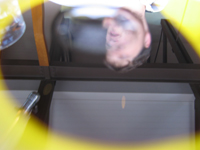From the Kitchen #21
 Vivaldi in the rain. How wonderful to be sitting inside near the heater, dog at my feet, a steady, heavy rain forming a curtain outside the window, with Vivaldi’s oboe concerto in F (RV447) with oboist Alfredo Bernardini, playing loudly; filling the house with soaring, sonorous cadences and thrilling demi-semi-quavers. Ah, nature and nurture in a beautiful harmony.
Vivaldi in the rain. How wonderful to be sitting inside near the heater, dog at my feet, a steady, heavy rain forming a curtain outside the window, with Vivaldi’s oboe concerto in F (RV447) with oboist Alfredo Bernardini, playing loudly; filling the house with soaring, sonorous cadences and thrilling demi-semi-quavers. Ah, nature and nurture in a beautiful harmony.
I’ve often heard it said that the Baroque composers were two-dimensional. There was also a teacher at the Melbourne Conservatorium in the 1970s who claimed that two distinguishing hallmarks of Baroque music were its lack of dissonance and its lack of chromatic passages. Piffle! The weather, for instance, provided rich inspiration for many Baroque composers. Jean-Fery Rebel (1666-1747) accosted his listeners’ ears with six minutes of dissonance in his ‘Le Cahos’ (Chaos), part of his suite ‘Les Éléments’. And Vivaldi knew how to create instrumental storms, for instance in parts of ‘The Four Seasons’. And for chromatic passages you don’t have to go past J S Bach. I have played many Bach flute and recorder pieces which were full of difficult-to-play (and sometimes listen to) passages of chromatic progression as well as dissonant tension between soloist and piano.
All of this has to do with categorisation. Academics (and others) often like to have things labelled and organised in boxes – it makes life simpler and makes it less stressful (interesting) for their students; it makes it easier to learn facts and regurgitate them on demand.
We hear as much ‘old’ music on ABC & MBS FM radio now as more recent work. By ‘old’ I mean anything written before 1800, although the 1800s are becoming ‘old’. This older music was being rediscovered in the first half of the 20th century, prompted by such figures as Arnold Dolmetsch. His son Carl ‘reinvented’ and popularised the recorder. Unfortunately, his making of cheap instruments possibly led to millions of children ending up hating the recorder, if not music itself.
There is a burgeoning growth in ‘authentic’ performances and recordings of old music. ‘Authentic’ denotes playing period instruments (or reproductions) and using playing techniques which are true to the music.
Period instruments can be authentic, but can the same be said of techniques? There are some historical records of playing techniques from various periods and some authoritative books. For instance, J J Quantz (1697 – 1773) wrote ‘how to’ books on recorder and flute technique. There are composers’ notes on manuscripts and published editions, indicating how passages or whole pieces were to be played. There were also informal written reports of performances which give modern players clues about how the music sounded all those centuries ago.
While it is interesting to hear a performance which may be close to the way someone in Leipzig in 1725 might have heard one of Bach’s violin concertos, it’s probably impossible to truly reproduce the conditions which existed at the time. Performances then were often in small drawing rooms or in cavernous palace chambers, with small groups of instrumentalists and relatively small audiences. Those in the audience may have been talking, even walking around. Would we tolerate that at a concert we’ve paid for? I’ve seen people get upset at children running around at free, open-air concerts. Even at the London ‘Promenade’ Concerts, people sit or stand quietly during most of the performances.
The question of authenticity also comes up in relation to photography. Many people bemoan the fact that we are now able to ‘muck around’ with an image, so that we can’t be sure whether what we’re being shown is ‘real’. But don’t forget that, before the invention of photography, the world and its people were recorded by painters. There was ample opportunity to depict anything but the ‘real’ thing. With photography, even if nothing is altered after the shutter is pressed, there is much which can be used to change how a scene is presented: angle, lighting, framing, lens specifications, depth of field, filters …
Looking out of the window now, I can imagine a number of ways to photograph what I see. I could include the window frame to enclose the scene; I could take the photo close to the wet glass and have the raindrops out of focus; I can use a very fast shutter and ‘freeze’ the rain outside or a slow shutter to blur it; I could focus into the middle of the rain or on the trees further away. I can make reality whatever I choose it to be.
The only thing that is authentic about the world is our experience of it and we can’t even be sure of that.
(PS The photo at the top is as it was taken – nothing has been done to alter it and it is printed the right way up. It illustrates my point about photography.)
© 2009 Daan Spijer
 CLICK HERE to download a formatted PDF of the above post
CLICK HERE to download a formatted PDF of the above post
 See more of Daan Spijer’s writing and his photos at Seventh House Communications
See more of Daan Spijer’s writing and his photos at Seventh House Communications